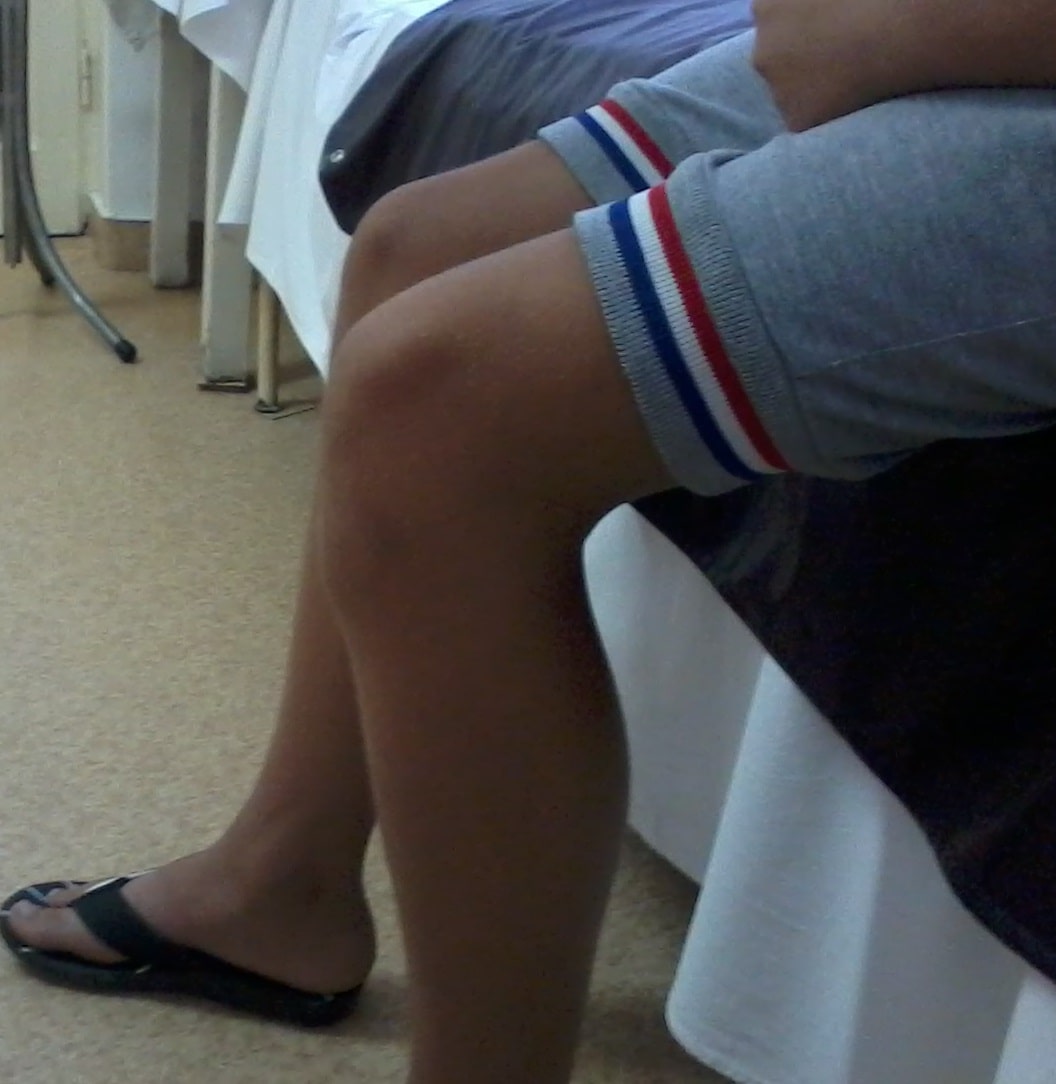Osgood-Schlatter Disease: Difference between revisions
| Line 45: | Line 45: | ||
==Prognosis== | ==Prognosis== | ||
The prognosis is generally reported as being good but the evidence for this claim is limited, and the common wisdom has been challenged.<ref name=":1" /> One case series of 51 10-14 year olds with OSD found that over one third of patients still have pain at two year follow up with a median pain duration of 42 months. This was associated with lower sports related function and quality of life. <ref>{{Cite journal|last=Holden|first=Sinead|last2=Olesen|first2=Jens Lykkegaard|last3=Winiarski|first3=Lukasz M.|last4=Krommes|first4=Kasper|last5=Thorborg|first5=Kristian|last6=Hölmich|first6=Per|last7=Rathleff|first7=Michael Skovdal|date=2021-08|title=Is the Prognosis of Osgood-Schlatter Poorer Than Anticipated? A Prospective Cohort Study With 24-Month Follow-up|url=https://pubmed.ncbi.nlm.nih.gov/34435066|journal=Orthopaedic Journal of Sports Medicine|volume=9|issue=8|pages=23259671211022239|doi=10.1177/23259671211022239|issn=2325-9671|pmc= | The prognosis is generally reported as being good but the evidence for this claim is limited, and the common wisdom has been challenged.<ref name=":1" /> One case series of 51 10-14 year olds with OSD found that over one third of patients still have pain at two year follow up with a median pain duration of 42 months. This was associated with lower sports related function and quality of life. <ref>{{Cite journal|last=Holden|first=Sinead|last2=Olesen|first2=Jens Lykkegaard|last3=Winiarski|first3=Lukasz M.|last4=Krommes|first4=Kasper|last5=Thorborg|first5=Kristian|last6=Hölmich|first6=Per|last7=Rathleff|first7=Michael Skovdal|date=2021-08|title=Is the Prognosis of Osgood-Schlatter Poorer Than Anticipated? A Prospective Cohort Study With 24-Month Follow-up|url=https://pubmed.ncbi.nlm.nih.gov/34435066|journal=Orthopaedic Journal of Sports Medicine|volume=9|issue=8|pages=23259671211022239|doi=10.1177/23259671211022239|issn=2325-9671|pmc=|pmid=34435066|via=|doi-access=}}</ref> | ||
There are documented cases of adults with residual clinical symptoms and radiological findings. This is termed '''unresolved Osgood-Schlatter Disease.''' | There are documented cases of adults with residual clinical symptoms and radiological findings. This is termed '''unresolved Osgood-Schlatter Disease.''' | ||
| Line 64: | Line 64: | ||
==Resources== | ==Resources== | ||
*{{Open access icon}} Systematic review of treatment recommendations by Neuhaus et al.<ref name=":1">{{Cite journal|last=Neuhaus|first=Cornelia|last2=Appenzeller-Herzog|first2=Christian|last3=Faude|first3=Oliver|date=2021-05-01|title=A systematic review on conservative treatment options for OSGOOD-Schlatter disease|url=https://www.sciencedirect.com/science/article/pii/S1466853X2100047X|journal=Physical Therapy in Sport|language=en|volume=49|pages=178–187|doi=10.1016/j.ptsp.2021.03.002|issn=1466-853X | *{{Open access icon}} Systematic review of treatment recommendations by Neuhaus et al.<ref name=":1">{{Cite journal|last=Neuhaus|first=Cornelia|last2=Appenzeller-Herzog|first2=Christian|last3=Faude|first3=Oliver|date=2021-05-01|title=A systematic review on conservative treatment options for OSGOOD-Schlatter disease|url=https://www.sciencedirect.com/science/article/pii/S1466853X2100047X|journal=Physical Therapy in Sport|language=en|volume=49|pages=178–187|doi=10.1016/j.ptsp.2021.03.002|issn=1466-853X|via=|doi-access=}}</ref> | ||
==References== | ==References== | ||
Latest revision as of 21:34, 7 April 2022
Osgood-Schlatter Disease (OSD) also known simply as Osgood-Schlatter is an apophysitis of the tibial tuberosity at the site of attachment of the patellar tendon that typically occurs in adolescents.
Pathophysiology
The exact cause is unknown. One prevalent hypothesis is that there is asynchronous development of the tibial tuberosity and the rectus femoris muscle during the maturation stage.
Before full maturity the apophysis is more susceptible to injury. Cartilage swelling and patellar tendon thickening can occur.
Epidemiology
Generally seen in active adolescents especially those involved in jumping and kicking activities. It is more common in boys but the gender gap is narrowing with increased participation of girls in sports. The average age is 8 to 13 in girls, and 10 to 15 in boys.[1]
Classification
| Classification | Description |
|---|---|
| Type 1: cartilage swelling alone | Hypoechoic zone superficial to the apophysis of the anterior tibial tubercle representing pretibial cartilaginous swelling with forward displacement of the subcutaneous tissues and elevation of the patellar tendon from the tibial outline on the longitudinal view |
| Type 2: cartilage swelling and bony changes | A fragmented and hypoechoic ossification center in addition to the abovementioned findings |
| Type 3: associated tendonitis | Diffuse thickening of the insertion of the patellar tendon with or without vacuolation |
| Type 4: associated bursitis | Fluid collection in the retrotendineal soft tissue representing infrapatellar bursitis |
Clinical Features
The patient has anterior knee pain. The pain is generally brought on by descending stairs, prolonged sitting with knees being immobile, kneeling, and with sporting activities.
Differential Diagnosis
Prognosis
The prognosis is generally reported as being good but the evidence for this claim is limited, and the common wisdom has been challenged.[1] One case series of 51 10-14 year olds with OSD found that over one third of patients still have pain at two year follow up with a median pain duration of 42 months. This was associated with lower sports related function and quality of life. [3]
There are documented cases of adults with residual clinical symptoms and radiological findings. This is termed unresolved Osgood-Schlatter Disease.
Treatment
There is limited data on treatment. In particular there is no evidence of the effectiveness of specific exercise programmes. Expert advice in review articles generally includes.[2]
- Rest (but not immobilisation)
- Activity modification (preference for activities like swimming and cycling)
- NSAIDs
- Ice
- Protective knee padding
- Physical therapy
- Surgical treatment in rare cases
Bracing, casting, and corticosteroid injections are generally not recommended.
Resources
 Systematic review of treatment recommendations by Neuhaus et al.[1]
Systematic review of treatment recommendations by Neuhaus et al.[1]
References
- ↑ 1.0 1.1 1.2 Neuhaus, Cornelia; Appenzeller-Herzog, Christian; Faude, Oliver (2021-05-01). "A systematic review on conservative treatment options for OSGOOD-Schlatter disease". Physical Therapy in Sport (in English). 49: 178–187. doi:10.1016/j.ptsp.2021.03.002. ISSN 1466-853X.
- ↑ 2.0 2.1 De Flaviis, L.; Nessi, R.; Scaglione, P.; Balconi, G.; Albisetti, W.; Derchi, L. E. (1989). "Ultrasonic diagnosis of Osgood-Schlatter and Sinding-Larsen-Johansson diseases of the knee". Skeletal Radiology. 18 (3): 193–197. doi:10.1007/BF00360969. ISSN 0364-2348. PMID 2665105.
- ↑ Holden, Sinead; Olesen, Jens Lykkegaard; Winiarski, Lukasz M.; Krommes, Kasper; Thorborg, Kristian; Hölmich, Per; Rathleff, Michael Skovdal (2021-08). "Is the Prognosis of Osgood-Schlatter Poorer Than Anticipated? A Prospective Cohort Study With 24-Month Follow-up". Orthopaedic Journal of Sports Medicine. 9 (8): 23259671211022239. doi:10.1177/23259671211022239. ISSN 2325-9671. PMID 34435066. Check date values in:
|date=(help)


